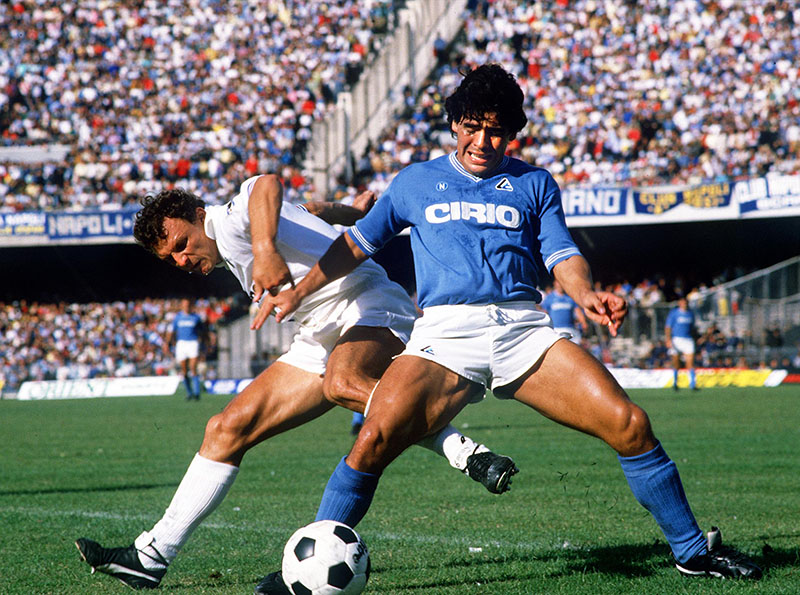
Asif Kapadia’s documentary on the Argentinian’s time at Napoli depicts how the man who won and lost the devotion of a city was targeted by dark forces on and off the pitch
24 March ~ Deserved praise is being heaped upon Oscar-winning director Asif Kapadia for Diego Maradona, the third in his series of personality documentaries following Amy (Winehouse) and (Ayrton) Senna. But a word of thanks should be offered up – perhaps via one of the Diego Maradona icons still adorning walls in Naples – to the late Jorge Cyterszpiler.
The agent who took the player from Boca to Barça and on to Napoli, Cyterszpiler features only fleetingly in the film, but without him it wouldn’t have been made. When Kapadia dared to mention the agent’s name during an interview which brings Maradona’s now gravelly voice to the film’s narration, the reply was emphatic: “No, he robbed me, I don’t want to talk about him.”
Instead there’s the footage Cyterszpiler commissioned, following Diego’s every move, as part of an aborted attempt to sell him to US soccer executives. Kapadia has cut over 500 hours’ worth – plus news reports, match coverage and home videos taken by friends, family and felons – into an intense, claustrophobic, mesmerising chronicle.
The opening sequence that follows the Fiat taking Napoli’s £6.9 million star signing from the airport to a packed San Paolo was reduced from 45 minutes to a matter of moments. Before Diego can be presented to 85,000 fans, there’s a chaotic press conference in the bowels of the stadium. When a reporter asks if Camorra (Naples mafia) money has bought the world’s most expensive player to Italy’s poorest city, it prompts a fiery denial from the club president and Diego – surrounded by a mob for the first of many times in the film – is propelled away from the media and on to the pitch. But the tone is set. The malign influence of the city’s crime syndicate follows the footballer throughout, as closely and cynically as his bone-crunching opponents on the pitch.
Cysterszpiler’s cameramen did a fine job focusing on the magician as we see him win two Scudettos, the UEFA Cup and the World Cup, while capturing vividly the brutality he suffered in the process. Diego growls in Spanish and the subtitles tell us how he adapted his game to combat the fouling. His personal trainer, Fernando Signorini, describes how training at altitude made Diego the dominant force he was during the 1986 World Cup. The voiceover comes as we witness, for the umpteenth time, the pace and power of his second goal against England in the quarter-final.
Napoli’s fans provide an exhausting supporting cast too. Derided as “cholera carriers” by Juventus and Milan ultras, their devotion to Diego is intense and the news reports of some fainting or having heart attacks in his presence seem believable. As Diego leads Napoli to their first ever league title the earthquake-stricken city erupts again. This time it’s the fans making the ground shake, declaring their love for him during a week-long celebration while fresh graffiti on the cemetery wall tells the dead: “You don’t know what you missed!”
The film charts a sad transformation as a naive, adulated Diego becomes the self-destructive, exploited and eventually despised Maradona – the reason both names are in the title. “For Diego I would go to the end of the earth. For Maradona I would not take a step,” Signorini insists.
Kapadia’s edit does elicit some sympathy. At times the subject’s expression is one of terror at being crushed by the crowds and possibly the weight of expectation. It’s only when he’s training in a deserted stadium – performing a dozen keepy-uppies using just his left heel – that he seems at peace.
His call for Neapolitans to support Argentina instead of Italy in the 1990 World Cup semi-final sounds a death knell for this love affair, but darker forces were already at work to pull them apart. With Cyterszpiler’s men sacked, it is left to one of the Camorra, armed with a camcorder, to capture the poignant final shots of Maradona as a Napoli player – sat alone and unloved at the team’s Christmas party.
Addicted and indebted, relying on club officials to get creative with his urine samples and caught in wiretaps requesting prostitutes and cocaine, Maradona’s fall – like everything else in this story – would be unfeasible as fiction, but is compelling as fact. Rob Kemp
Diego Maradona is currently free to watch in the UK via Channel 4’s All 4 on-demand service
Photo by Colorsport
This article first appeared in WSC 390, September 2019. Subscribers get free access to the complete WSC digital archive – you can find out more here
